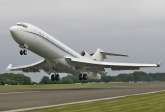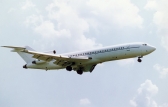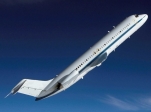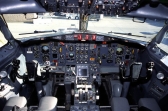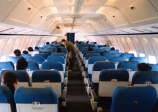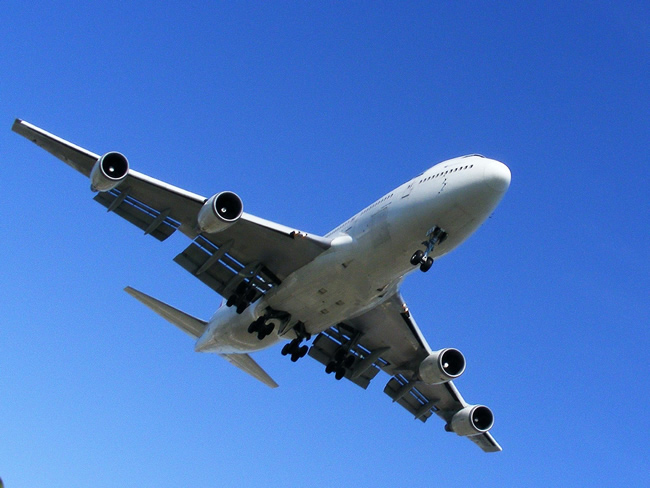
The Boeing 727 is a mid-size, narrow-body, three-engine, T-tailed commercial jet airliner, manufactured by Boeing. The Boeing 727 first flew in 1963, and, for over a decade, it was the most produced commercial jet airliner in the world. When production ended in 1984, a total of 1,831 aircraft had been produced. The 727's sales record for the most jet airliners ever sold was broken in the early 1990s by its younger stablemate, the Boeing 737.
The 727 was produced following the success of the Boeing 707 quad-jet airliner. Designed for short-haul routes, the 727 became a mainstay of airlines' domestic route networks. A stretched variant, the 727–200, debuted in 1967. In August 2008, there were a total of 81 Boeing 727–100 aircraft and 419 727–200 aircraft in airline service.
The 727 design arose as a compromise between United Airlines, American Airlines, and Eastern Air Lines requirements over the configuration of a jet airliner to service smaller cities, which often had shorter runways and smaller passenger demand. United Airlines wanted a four-engined aircraft for its flights to high-altitude airports, especially its hub at Stapleton International Airport at Denver, Colorado. American, which was operating the four-engined Boeing 707 and Boeing 720, wanted a twin-engined aircraft for efficiency reasons. Eastern wanted a third engine for its overwater flights to the Caribbean, since at that time twin-engined commercial flights were limited by regulations to routes with 60-minute maximum flying time to an airport (see ETOPS/LROPS). Eventually, the airlines agreed on a trijet.
The third JT8D engine, which is located at the very rear of the fuselage (called engine 2), is supplied with air from an inlet at the front of the vertical fin through an S-shaped duct to the engine's inlet. The 727 design featured high-lift devices on its wing, thus being one of the first jets able to operate from relatively short runways. Later models of the 727 were stretched to accommodate more passengers, and they ended up replacing earlier jet airliners, such as the Boeing 707 and Douglas DC-8, on domestic routes.
The 727 proved to be such a reliable and versatile airliner that it came to form the core of many start-up airlines' fleets. The 727 was successful with airlines worldwide partly because of its capability to use smaller runways while still flying medium-range routes. This effectively allowed airlines to attract passengers from cities with large populations but smaller airports to worldwide tourist destinations. One of the features that gave the 727 its ability to land on shorter runways was its unique wing design. Due to the absence of wing-mounted engines, leading-edge lift enhancement equipment (Krueger, or hinged, flaps on the inner portion of the leading edge, and extendable leading edge slats on the remainder of the leading edge), and trailing-edge lift enhancement equipment (triple-slotted, aft-moving flaps) could be used on the entire wing. The combination of these high-lift devices produced a maximum wing lift coefficient of 3.6 (based on the flap-retracted wing area). Resultingly, the 727 could fly with great stability at very low speeds compared to other early jets; however, many domestic carriers operating the 727 discovered, after various accident reviews, that the 40-degree flaps setting could result in a higher-than-desired sink rate or the prospect of a stall on final approach. As a remedy, these carriers imposed a restriction in their respective corporate Pilots' Operation Handbooks on using more than 30 degrees' flaps on the 727, even going so far as to installing lockout plates on the flap slot to prevent selection of more than 30 degrees' flaps.
Initially, the early 727s had nose gear brakes fitted to further decrease braking distance upon landing, but these were soon removed from service, as they provided little useful reduction in braking distances, while adding weight and increasing maintenance requirements.
The 727 was designed to be used at smaller, regional airports, so independence from ground facilities was an important requirement. This gave rise to one of the 727's most distinctive features: the built-in airstair that opens from the rear underbelly of the fuselage. D. B. Cooper, a hijacker, parachuted from the back of a 727 as it was flying over the Pacific Northwest. Boeing subsequently modified the design with the Cooper vane so that the airstair could not be lowered in flight. Another innovation was the inclusion of an auxiliary power unit (APU), which allowed electrical and air-conditioning systems to run independent of a ground-based power supply, without having to start one of the main engines. The 727 is equipped with a retractable tail skid that is designed to protect the aircraft in the event of an over-rotation on takeoff. The 727's fuselage has an outer diameter of 148 inches (3.8 m). This allows six-abreast seating (three per side) and a single central access walkway when 18 inches (46 cm) wide coach-class seats are installed. An unusual feature of the fuselage is the 10 inch difference between the lower lobe forward and aft of the wing as the higher fuselage height of the centre-section was simply retained towards the rear.
Plane info
Cruise speed: 926 km/h
Total range: 3 056 km
Engines: 3 x P&W JT8D-7, −9, −15, −17R&S
Aircraft dimensions
Wingspan: 32.9 m
Length: 40.6 m
Height: 10.3 m
Cabin
Passengers: up to 149


